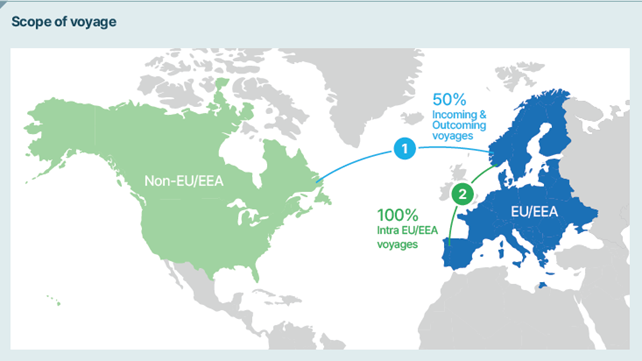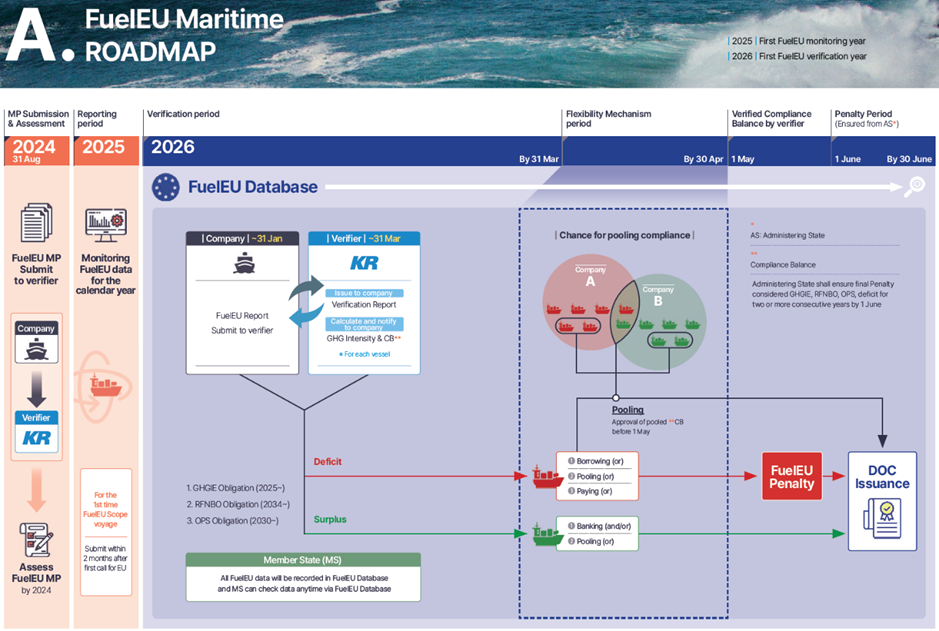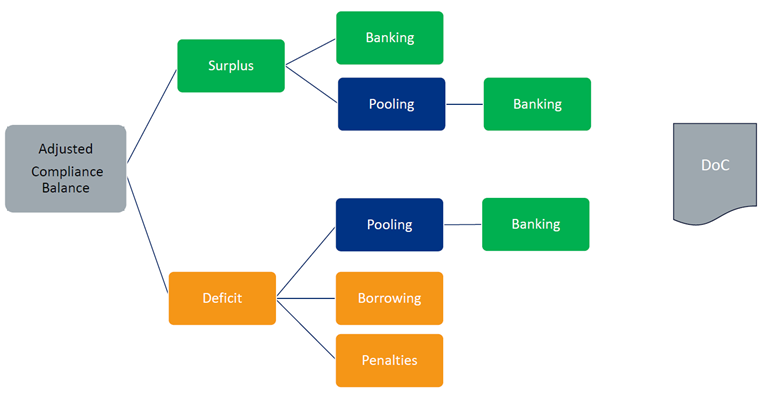-
- Notice for Amendments to KR Classification Technical Rules (Guidance Relating to the Rules for the Classification of Steel Ships Pt 1)
- Revision of “Guideline for Shaft Generator Systems”
- SDC11-New Flash
- PPR 12-News Brief.
- Guidance regarding the temporary storage of treated sewage and/or grey water in ballast water tanks (Rev.1)
- Interim Guidance on the Application of the BWM Convention to ships operating in Challenging Water Quality conditions (Rev.1)
- Hong Kong - New instruction for implementation and compliance with MLC 2022 Amendment
- Notice for Amendments to KR Classification Technical Rules (Guidance Relating to the Rules for the Classification of Steel Ships Pt 1)
- Revision of “Guideline for Shaft Generator Systems”
- SDC11-New Flash
- PPR 12-News Brief.
- Guidance regarding the temporary storage of treated sewage and/or grey water in ballast water tanks (Rev.1)
- Interim Guidance on the Application of the BWM Convention to ships operating in Challenging Water Quality conditions (Rev.1)
- Hong Kong - New instruction for implementation and compliance with MLC 2022 Amendment
-
- Notice for Amendments to KR Classification Technical Rules (Guidance Relating to the Rules for the Classification of Steel Ships Pt 1)
- Revision of “Guideline for Shaft Generator Systems”
- SDC11-New Flash
- PPR 12-News Brief.
- Guidance regarding the temporary storage of treated sewage and/or grey water in ballast water tanks (Rev.1)
- Interim Guidance on the Application of the BWM Convention to ships operating in Challenging Water Quality conditions (Rev.1)
- Hong Kong - New instruction for implementation and compliance with MLC 2022 Amendment
Green Ship Technology Team
SONG June-young, PARK Ki-ho, KIM Jin-hee
1. Introduction to the Regulation
As part of its efforts to reduce greenhouse gas (GHG) emissions, the European Commission (EC) introduced the "EU Fit for 55" legislative package in July 2021. The "Fit for 55" package aims to reduce GHG emissions by 55% from 1990 levels by 2030. One of the components directly linked to international shipping is the FuelEU Maritime regulation.
FuelEU Maritime is a legislative measure to promote the use of renewable and low-carbon fuels in maritime transport, targeting ships calling at ports within the European Union (EU) and European Economic Area (EEA), regardless of their flag state. It seeks to stimulate demand for green fuels and enhance the use of Onshore Power Supply (OPS) and Zero-Emission Technologies (ZET) at ports by gradually tightening GHG intensity limits of marine fuels through 2050.
This regulation applies to all ships of 5,000 gross tonnage or more operating within the EU, under the following conditions:
- 100% of the energy used while at a port of call within the EEA.
- 100% of the energy used during voyages between ports within the EEA.
- 50% of the energy used on voyages arriving at or departing from an outermost region under EEA jurisdiction.
- 50% of the energy used on voyages between an EEA port and a third-country port.

[FuelEU Maritime Geographical Scope]
GHG emissions considered under this regulation include carbon dioxide (CO2), methane (CH4), and nitrous oxide (N2O). The GHG intensity is measured as the Well-to-Wake (WtW) emissions per unit of energy consumed (gCO2eq/MJ). Compensatory factors, such as fwind for wind propulsion, and a double credit mechanism (RWD) for Renewable Fuels of Non-Biological Origin (RFNBOs), are also applied for compliance calculations.
By 2031, ships using less than 1% RFNBOs in their annual energy mix at EU ports must ensure a minimum of 2% RFNBO usage starting in 2034.
* WtW (Well to Wake): the entire process of fuel production, delivery, and use on ships,
along with all emissions produced during this process
2. Verification Procedures and Compliance by Ship Operators
Existing vessels operating in the EU must have their FuelEU Monitoring Plan (FuelEU MP) approved by the end of 2024. Newly registered vessels must obtain approval within two months of their first EU port call.
From January 1, 2025, vessels shall collect FuelEU Data following methodologies outlined in their approved FuelEU MP. Operators are required to submit this data to verification bodies by January 31 each year. Verification bodies will assess the annual GHG intensity and Compliance Balance of each vessel, issuing a Verification Report by March 31.

[FuelEU Maritime Verification Procedure]
Following confirmation and finalization of the Compliance Balance, any surplus or deficit is determined based on the annual GHG intensity target:Decarbonization regulations for ships, including FuelEU Maritime, are rapidly becoming more stringent. These regulations are expected to become increasingly diverse and complex, and KR is providing verification services for the entire verification field required by the EU/UK regulations.
• Compliance Surplus: Positive(+) Compliance Balance.
• Compliance Deficit: Negative(-) Compliance Balance.
Operators may request the Flexibility Mechanism by April 30, with options including:
1) For Surplus:
- Banking for future use.
- Pooling and Banking.
2) For Deficit:
- Pooling and Banking.
- Borrowing.
- Paying Penalties.

[Compliance Options]
(Reference : EMSA)
The ship operator may address a compliance deficit either by paying a penalty to the designated EU Member State or by borrowing pre-compliance surpluses from the previous reporting period, applying a multiplier of 1.1, to offset the compliance deficit for the current reporting period. However, the borrowing limit for pre-compliance surpluses must not exceed 2% of the product of the vessel's energy consumption and the GHG intensity limit for the reporting period. Additionally, borrowing cannot be utilized for two consecutive years.
If a compliance surplus occurs during the reporting period, the ship operator may bank the surplus for use in the following reporting period. Additionally, the compliance balances of two or more vessels may be pooled, allowing a vessel with a compliance surplus to transfer the surplus to another vessel with a compliance deficit to offset the shortfall. However, the amount of the compliance surplus that can be transferred is limited to ensure that the transferring vessel does not incur a compliance deficit as a result of the transfer.
Following the implementation of the flexibility mechanism, ship operators will receive the Verified Compliance Balance for each vessel by May 1. Based on this, the Administering State will verify the compliance status of each vessel by June 1. For vessels in compliance, a Document of Compliance will be issued. For non-compliant vessels, the Document of Compliance will be issued only after confirming that the ship operator has paid the required penalties.
3. KR’s EU/UK GHG Regulation Service
Decarbonization regulations for ships, including FuelEU Maritime, are rapidly becoming more stringent. These regulations are expected to become increasingly diverse and complex, and KR is providing verification services for the entire verification field required by the EU/UK regulations.
1) EU/UK MRV MP
2) EU/UK MRV Emission Report
3) FuelEU Maritime Report
4) Emission report at Company Level
In addition to these verification services, KR aims to simplify regulatory compliance, reduce associated costs, and support shipowners in implementing effective decarbonization strategies through system development and technical documents.
We aim to be a partner that enhances ship operators' competitiveness and leads the sustainable shipping industry in the era of upcoming environmental regulations.
